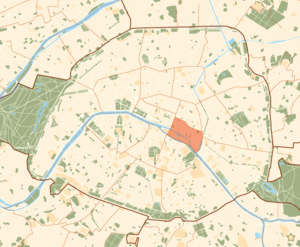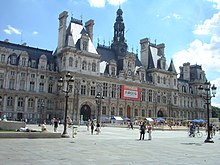4th arrondissement (Paris)
|
4th Arrondissement (Hôtel-de-Ville) Arrondissement municipal of Paris |
|
|---|---|
| Coordinates | 48 ° 51 '37 " N , 2 ° 21' 1" E |
| height | 35 m (27- 38 m ) |
| surface | 1.61 km² |
| Residents | 28,088 (Jan. 1, 2017) |
| Population density | 17,446 inhabitants / km² |
| INSEE code | 75104 |
| Post Code | 75004 |
| Website | mairie4.paris.fr |
| structure | |
| Quarters | |
The 4th arrondissement of Paris , the Arrondissement de l'Hôtel de Ville , is one of the oldest parts of the city. Its southern limit is the northern bank of the Seine in the city center. The history of the arrondissement (city district) has its origins in the early settlements on the Seine islands and further in the expansion of the city in the 16th century.
Geographical location
The 4th arrondissement is located directly on the right bank of the Seine . It is bordered by the 1st arrondissement in the west, the 3rd arrondissement in the north and the 11th and 12th arrondissement in the east . The 5th arrondissement is on the opposite side of the Seine . The eastern part of the Île de la Cité and the Île Saint-Louis also belong to the 4th arrondissement.
Quarter in the 4th arrondissement
The 4th arrondissement consists of the following four districts:
- Saint-Merri district
- Saint-Gervais district
- Quartier de l'Arsenal
- Notre-Dame district
According to the official census of the Parisian neighborhoods, these are quarters 13 to 16.
Part of the 4th (and 3rd) arrondissement is also known as the Marais .
population
According to the 1999 census, 30,680 inhabitants are registered in the 160 hectare arrondissement. This corresponds to a population density of 19,172 inhabitants / km² and 2% of the Paris population.
The population has remained stable compared to the other arrondissements of the city center since 1982, after a large population decrease from 1962. The northern part of the 4th arrondissement is the traditional center of the Jewish community of Paris. Today a large community of Orthodox Jews lives here , whose shops and restaurants along the Rue des Rosiers have become a magnet for tourists. The former aristocratic palaces in the Marais were at the beginning of the 20th century a magnet for destitute immigrants from the French provinces and from Eastern Europe, they housed small craft workshops and specialist shops. At the end of the 1960s, with the renovation of the old hôtels particuliers, a development of gentrification began that has now been completely completed. The 4th arrondissement is now inhabited by numerous artists and intellectuals; Foreign millionaires and wealthy investors are increasingly maintaining second homes here, as in other inner-city districts of Paris, which has long been the case on the islands of Île de la Cité and Île Saint-Louis . The arrondissement is also a center of the Parisian LGBT scene.
Politics and administration
town hall
The town hall of the 4th arrondissement is at Place Baudoyer 2, 75004 Paris, phone: 01 44 54 75 80.
mayor
Mayor of the 4th arrondissement has been Ariel Weil der Parti socialiste , who took over the office from his predecessor Christophe Girard (also PS), who ruled from 2012 to 2017, since 2017 .
Attractions
See also: List of monuments historiques in the 4th arrondissement (Paris)
- Center Georges Pompidou
- Cité Internationale des Arts Paris
- Église des Billettes
- House of Victor Hugo
- Hotel de Beauvais
- Hotel de Sens
- Hotel de Sully
- Hotel de Ville
- Hôtel-Dieu
- Hotel Lambert
- Hotel Lamoignon
- Notre-Dame de Paris
- Mémorial des Martyrs de la Déportation
- Mémorial de la Shoah
- Maison européenne de la Photographie (museum)
- Mickiewicz Museum
- Pavillon de l'Arsenal
- Place de la Bastille
- Place des Vosges
- Église Saint-Gervais-Saint-Protais
- Église Saint-Louis-en-l'île (on the Île Saint-Louis )
- Église Saint-Paul-Saint-Louis
- Église Saint-Merri
- Synagogue on Rue Pavée
- Théâtre de la Ville
- Tour Saint-Jacques
The royal palaces Hôtel Saint-Paul and Hôtel des Tournelles no longer exist .
Green areas
- Place des Vosges
- Square Jean XXIII
Transport and infrastructure
Major roads
- Avenue Victoria
- Boulevard Beaumarchais
- Bourdon Boulevard
- Boulevard du Palais
- Boulevard Morland
- Boulevard de Sébastopol
- Boulevard Henri IV
- Rue de Rivoli
- Rue du Renard
- Rue Saint-Antoine
- Rue Saint-Martin
- Rue Vieille du Temple
- Quai de l'Hôtel de Ville
- Quai des Célestins
- Quai des Gesvres
- Quai Henri IV
Important places
- Place de la Bastille
- Place de l'Hôtel-de-Ville
- Place des Vosges
- Place du Châtelet
- Place du Paris Notre Dame
- Place Lépine
Railway stations and metro lines
Metro lines 1 and 7 cross the 4th arrondissement from east to west, while line 4 serves the Ile de la Cité in the southwest of the arrondissement. The Châtelet and Bastille transfer stations are also on the edge of the arrondissement.
The RER does not have a train station in the 4th arrondissement, but the Châtelet - Les Halles train station , which is served by lines A , B , and D , is immediately to the west and also has exits to the 4th arrondissement.
Bridges within the 4th arrondissement
- Pont au Change (Île de la Cité)
- Pont d'Arcole (Île de la Cité)
- Pont de Sully (Île Saint-Louis)
- Pont Louis Philippe (Île Saint-Louis)
- Pont Marie (Île Saint-Louis)
- Pont Notre-Dame (Île de la Cité)
- Pont Saint-Louis (Île de la Cité - Île Saint-Louis)
See also
Web links
- www.mairie4.paris.fr Official website of the arrondissement
- www.parisbalades.com Detailed description of the architecture







